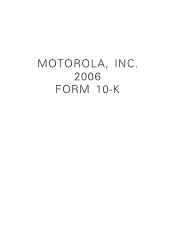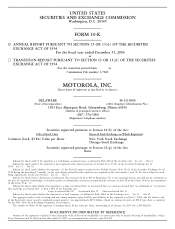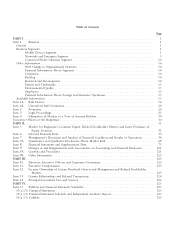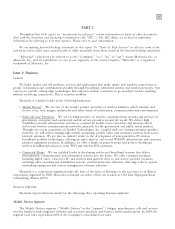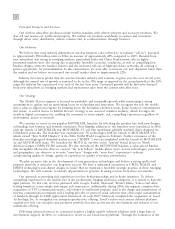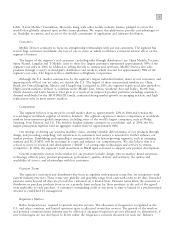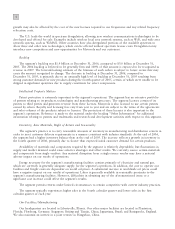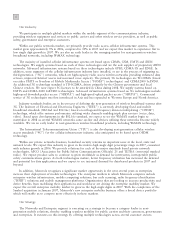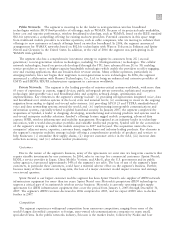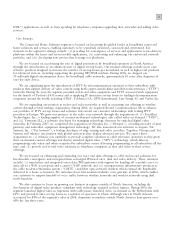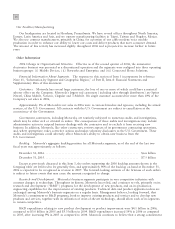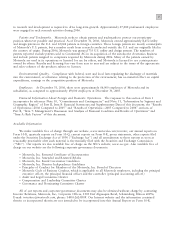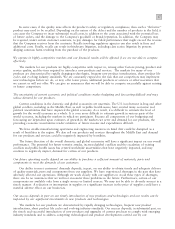Motorola 2006 Annual Report Download - page 15
Download and view the complete annual report
Please find page 15 of the 2006 Motorola annual report below. You can navigate through the pages in the report by either clicking on the pages listed below, or by using the keyword search tool below to find specific information within the annual report.
7
Public Networks. The segment is investing to be the leader in next-generation wireless broadband
technologies with its MOTOwi4 portfolio of offerings, such as WiMAX. Because of its projected early availability,
lower cost and superior performance, wireless broadband technology, such as WiMAX, based on the IEEE standard
802.16e represents a compelling offering for existing and new providers. Potential customers in this space range
from traditional mobile providers to wireline operators, such as cable companies, who are moving to enhance their
offerings to new customers or launch offerings based on wireless broadband. In 2006, the segment announced
arrangements for WiMAX networks based on 802.16e technologies with Wateen Telecom in Pakistan and Sprint
Nextel and Clearwire in the United States. In addition, at the end of 2006 the segment was participating in 22
WiMAX trials globally.
The segment also has a comprehensive investment strategy to migrate its customers from 2G (second-
generation) to next-generation wireless technologies, including 3G (third-generation) technologies. The cellular
network technologies, based on protocols developed through the ITU, have advanced from 2G to 3G enabling
service providers to move to higher-capacity bandwidth technologies which enable the providers to offer engaging,
new and exciting applications that can broaden their revenue stream. Many cellular operators, particularly in
emerging markets, have not begun their migration to next-generation access technologies. In 2006, the segment
announced a collaboration with Huawei Technologies, Co., Ltd. to bring an enhanced and extensive portfolio of
UMTS and HSDPA/HSUPA infrastructure equipment to customers worldwide.
Private Networks. The segment is the leading provider of mission-critical systems worldwide, with more than
65 years of experience in custom, rugged devices; public safety-grade private networks; sophisticated encryption
technology; interoperable voice and broadband data; and complex network design, optimization and
implementation. Key elements in the segment's strategy include: (i) providing next-generation integrated voice, data
and broadband over wireless systems at the local, state and national levels; (ii) continuing to invest in the ongoing
migration from analog to digital end-to-end radio systems; (iii) providing APCO 25 and TETRA standards-based
voice and data networking systems around the world; and (iv) implementing interoperable communications and
information systems, especially related to global homeland security. In January 2007, the segment completed the
acquisition of Symbol, a leader in designing, developing, manufacturing and servicing products and systems used in
end-to-end enterprise mobility solutions. Symbol's offerings feature rugged mobile computing, advanced data
capture, RFID, wireless infrastructure and mobility management. Recognized as an industry leader in technology
innovation, with a world-class product portfolio and valuable intellectual property, Symbol will be the cornerstone
of the segment's strategy to enable the mobile enterprise in 2007 and beyond. The acquisition unites the two
companies' adjacent assets, expertise, customer bases, supplier bases and industry-leading products. Key elements in
the segment's enterprise mobility strategy include offering a comprehensive portfolio of products and services to
help businesses: (i) streamline their supply chains, (ii) improve customer service in the field, (iii) increase data
collection accuracy, and (iv) enhance worker productivity.
Customers
Due to the nature of the segment's business, many of the agreements we enter into are long-term contracts that
require sizeable investments by our customers. In 2006, sales to our top five commercial customers (Sprint Nextel;
KDDI, a service provider in Japan; China Mobile; Verizon; and Alltel), plus the U.S. government and its public
safety agencies, represented approximately 34% of the segment's net sales. The loss of any of the segment's large
customers, in particular these customers, could have a material adverse effect on the segment's business. Further,
because many of these contracts are long-term, the loss of a major customer would impact revenue and earnings
over several quarters.
Sprint Nextel is our largest customer and the segment has been Sprint Nextel's sole supplier of iDEN network
infrastructure equipment for more than ten years. Sprint Nextel uses Motorola's proprietary iDEN technology to
support a critical part of its nationwide wireless service business. Motorola is currently operating under supply
agreements for iDEN infrastructure equipment that cover the period from January 1, 2005 through December 31,
2007. The segment's iDEN revenues decreased in 2006 compared to 2005, and we expect iDEN sales to decline
further in 2007.
Competition
The segment experiences widespread competition from numerous competitors, ranging from some of the
world's largest diversified companies to foreign, state-owned telecommunications companies to many small,
specialized firms. In the public networks industry, Ericsson is the market leader, followed by Nokia and four


